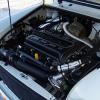This lot might seem a little broken up and maybe a little repetative, but its stuff i'm noting down as its whirring round my head.
There has been no mention in this topic as to why the white wire burnt out in the first instance. That is where you should start to look!! the wire will burn out only with a dead short to ground or extreme overload. I'd be trying to find that than looking at anything else.
It's not clear which part of the white wire in the loom has burnt out, if you tell us this, it might make it clearer where the problem may lie.
The 3AS alarm imobiliser box inhibits only the starter motor. The 5AS box inhibits the starter motor as well as the ignition, injector and fuel pump circuits via the ECU digital code on the grey/ white wire. No matter what you do, you will never be able to wire round it 100% to even bump start the engine.
The white wire onto the alarm ECU is only for an input signal (ignition sense), much the same as it is on the engine ECU, there is no real load drawn on these circuits. The white also feeds the fuel pump relay coil in the relay pack, not the fuel pump itself, so again draws no real load. The white also feeds the charge warning light on the dash, again drawing no real load.
The brown from the fuse link onto the ignition switch in position II leaves as white to the fuse where it then is distributed to the above circuits. The wire from the ignition switch before the fuse is a very heavy wire since it needs to survive a dead short to ground long enough to make sure the fuse link blows instead of starting a fire.
The charge light on the dash works in a wonderful way. The white wire feeds 12v through the bulb onto the brown/ yellow wire to the alternator where it grounds. The current drawn by the charge light creates a magnetic field in the field winding of the alternator. This is what really makes the alternator work when it starts turning. Without it (bulb blown or missing) the alternator will not generate any voltage. OK so the alternator is generating voltage as the engine starts and as a result the charge light ground now has a 12v potential. one cancels out the other, the charge light draws no current. There is a hidden diode in the brown yellow wire that prevents the alternator back feeding 12v through the charge light, thereby keeping the ECU live and engine running even with the ignition key turned off and even removed from the switch altogether.
Ok so thats all explained, it should be easy to find where the fault is. If the wire that burnt out was the heavy white wire from the ignition switch and not the lighter gauge wires after the fuse, there is a ground fault on that wire somewhere, and likely blown the fuse link and likely damaged the ignition switch since 12v divided by 0.001 ohms would be 12000amps instantanious (can you see why the wires melt and burn?) Check for dodgy aditional wiring for the likes of a sterio or cigarret lighter/ socket.
With the burnt wiring replaced and the fault repaired, there should be 12v on the brown wires on the ignition switch and 12v on the white when switched to position II (IGN) or III (Crank). No volts on the browns means a fuse link has blown at the starter motor. 12v on the browns and no volts on the white at pos II or III means the ignition switch is faulty. Oh and there is the multi plug connector on the column, thats a good place for a bad contact as well
Going back to what you described earlier, if there is zero volts with both alarm and engine ECU's connected, removing them, there is 12v on the white, could suggest that perhaps there is a high resistance in the circuit, that drops the volts right off when any current is drawn (likely the ignition switch after the stress of 12000amps dead short in my mind)
Position I (Aux) will only have 12v on the green, the white will be zero volts.
You could disconnect the battery and check the resistance between the brown and white wires on the ignition switch with the switch in the correct position II or III. There should be zero resistance.
There couldn be a faulty engine or alarm ECU, alternator, or wiring, but you need to try and find why the wiring melted in the first instance and where it melted in the loom
Edited by Sprocket, 12 October 2011 - 10:36 PM.
missed out a teeny bit :)














